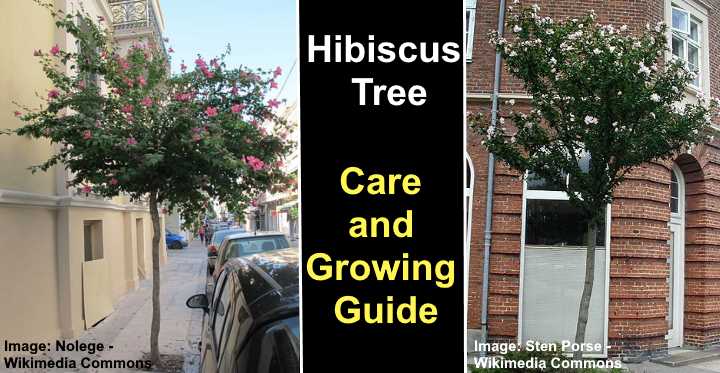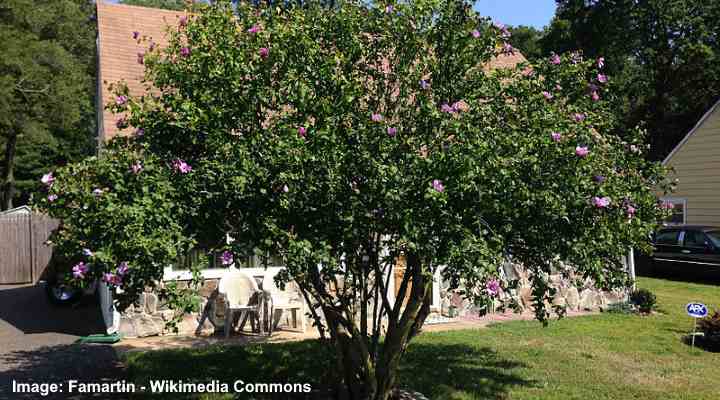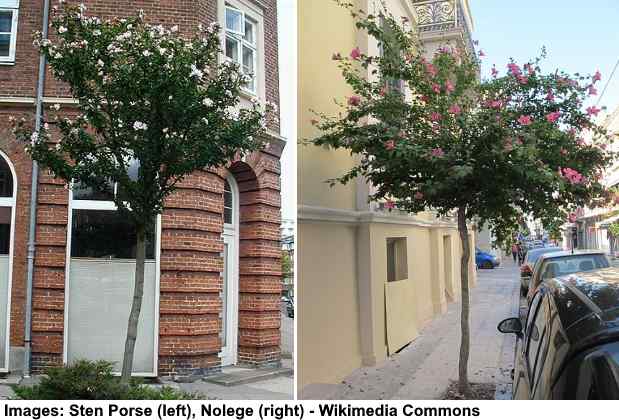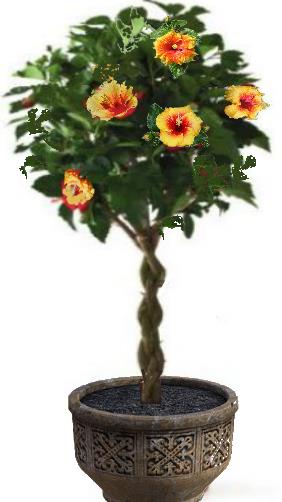Hibiscus Tree: Care and Growing Guide (Including Braided Hibiscus)

The hibiscus tree is a flowering ornamental plant with large, showy, trumpet-shaped flowers. Hibiscus trees have large tropical flowers between 3” and 8” (7 – 20 cm) across that grow in hues of pink, red, lilac, purple, blue, and white. Hibiscus trees are easy to grow in gardens as long as they get plenty of sunshine. Plenty of light means that the sizeable shrubby tree blooms continuously throughout the summer.
About Hibiscus Trees
There are two types of hibiscus trees: braided hibiscus that grows in tropical climates and the tree form of Hibiscus syriacus (Rose of Sharon) which is a hardy hibiscus.
The Hibiscus syriacus (Rose of Sharon) is a large hardy shrub that grows in northern climates. The multi-stemmed shrub can be trained to grow as a tree with a single trunk. Although best growing in the ground, smaller hibiscus trees can grow in pots.

Rose of Sharon (Hibiscus syriacus) grows as a multi stemmed shrub, but can be trained to grow as a single trunk hibiscus tree
Braided Hibiscus Tree
The braided hibiscus tree is the Chinese hibiscus (Hibiscus rosa-sinensis). This hibiscus species is a tropical plant suitable for growing in gardens and pots in warm climates. The stems of several Chinese hibiscus plants are braided to create the braided hibiscus. The braided hibiscus is usually grown in pots.

Braided hibiscus tree. The braided hibiscus is the Chinese hibiscus (Hibiscus rosa-sinensis).
You can grow potted braided hibiscus trees in colder climates as long as you bring them indoors during winter.
This article is a complete guide to growing hibiscus trees in your garden. You will find helpful tips on caring for these beautiful flowering trees to ensure that they bloom all summer long, year after year.
How to Care for Hibiscus Tree
To care for hibiscus trees, plant the large shrub-like tree in well-draining soil that is always moist. Water hibiscus trees regularly in summer to keep them blooming. Ensure the trees grow in full sun where they get at least six hours of sunshine daily. Fertilize hibiscus trees occasionally.
Hibiscus Tree Facts
Hibiscus trees are large bushy flowering shrubs in the mallow family Malvaceae. Tropical hibiscus and cold-hardy hibiscus plants are famous for their abundance of large, showy, colorful flowers.
Hibiscus trees (Hibiscus syriacus) are deciduous plants that are hardy in USDA zones 5 through 8. The minimum temperature for hardy hibiscus trees is as low as 0°F (-17°C).
Braided hibiscus trees (Hibiscus rosa-sinensis) are evergreen plants that only grow in USDA zones 10 through 12. The minimum temperature for braided hibiscus is 50°F (10°C).
Hibiscus Tree (Hibiscus Syriacus) Care Guide
First, we will look at how to care for the hardy hibiscus tree, the rose of Sharon (Hibiscus syriacus).
Sun Requirements for Growing Hibiscus Tree

In the pictures: single stemmed hibiscus tree (Hibiscus syriacus). Hibiscus trees prefer a sunny location but will tolerate part-shade
Grow hibiscus trees in the sunniest part of your front or backyard. Typically, hibiscus trees require plenty of sunshine every day—at least six hours. However, hibiscus trees will also grow in partial shade, which is ideal in hot climates. Hardy hibiscus trees don’t grow well in deep shade.
Hibiscus trees produce more flowers when grown in plenty of light. However, extremes in sun exposure can affect the plant’s growth. Direct, intense midday sun in hot summers can cause leaves to turn yellow.
If the hibiscus tree is in continual shade, it can suffer from fungal problems due to high moisture. A lack of sunlight is also to blame for hibiscus trees flower buds not opening.
The Best Soil for Growing Hibiscus Tree
Plant hibiscus trees in rich, fertile soil that drains well. During warm weather, the soil needs to hold enough moisture to stay moist between watering. The best way to improve the soil for growing hibiscus is to add organic compost and a layer of mulch.
The worst thing when growing hibiscus trees is if their roots sit in soggy, waterlogged soil. On the other hand, arid ground is also detrimental to hibiscus growth.
Because hibiscus trees are generally easy to care for, they adapt well to a wide range of soil types. You can grow hibiscus in sandy, clay, loamy, or chalky soil. The hardy shrubs also survive growing in poor soil.
If you notice water pooling around the hibiscus tree’s trunk, you will need to amend the soil so that it drains better. Or you might have to dig up the flowering tree and replant in a better location.
How to Water a Hibiscus Tree

Water hibiscus tree regularly in the summer and less frequently in the winter, but don’t let the ground dry out completely
Hibiscus trees need regular watering to grow well and add color to garden landscapes. During summer, water hibiscus trees as often as once a week by thoroughly soaking the soil. If you get scorching weather, water the trees more frequently. In winter, water hibiscus plants less often.
It’s best to let the ground partially dry out between watering to care for a hibiscus tree. Hibiscus is a relatively drought-tolerant plant. So, the flowering shrub will grow better if you slightly under-water it rather than overwater it.
However, don’t let the ground dry out completely. Hardy hibiscus trees growing in parched soil tend to suffer from bud drop. This results in fewer flowers and may cause the tree’s growth to wilt.
Hibiscus Tree Care – Temperature
Hibiscus tree (Hibiscus syriacus) withstands freezing temperatures when growing outdoors. Hardy hibiscus trees thrive in zones 5 through 8, where temperatures dip below 0°F (-17°C). If temperatures drop below -4°F (-20°C), you will have to protect the plant from severe cold.
Hibiscus tree (Hibiscus syriacus) also thrives in warm temperatures. Even in Southern states, you can plant hardy hibiscus trees in backyards. If the summers get extremely hot, it’s crucial to water the plant frequently and protect it from intense sunlight.
Humidity Requirements for Hibiscus Tree Outdoors
Hibiscus trees are tolerant of humidity and can withstand a wide range of conditions. Humidity can become an issue for hibiscus if it grows in constant shade. Air moisture and a lack of sunlight can result in fungal diseases. Additionally, the large spreading crown should have enough room to grow to let enough air circulate.
How to Fertilize Hibiscus Tree
Hardy hibiscus trees are moderate feeders and can benefit from occasional fertilization. Use a balanced tree fertilizer with an NPK rating of 10-10-10 and apply in early spring. You can then apply fertilizer again in mid-summer to encourage more flowers to bloom. Apply the fertilizer around the drip line of the crown to ensure all the roots get nourishment.
Don’t over-fertilize the hibiscus tree – it may be best to use a slow-release fertilizer to care for your flowering tree. Too much fertilization can end up causing too much foliage, few flowers, and burnt roots.
Tropical species of hibiscus trees need more fertilization than the hardy varieties.
How to Prune Hibiscus Tree

If you want to train hibiscus shrub (in the picture) to grow as a tree, prune lower stems to create one main trunk
Hibiscus shrubs don’t require much pruning. However, if you want to grow a hibiscus tree, you’ll need to prune the stems growing from the ground so that one main trunk grows. Regular hibiscus pruning requires removing dead growth in late winter or early spring. Pruning also helps keep the shape of hibiscus trees.
It’s important to remember that buds form on new growth. So, it would be best if you pruned the shrubby tree before new growth appears in spring.
Hibiscus Tree Care During Winter
Protect the hibiscus plant by covering the root zone with a thick layer of mulch. It is also a good idea to lightly wrap the plant in hessian or burlap to protect the tree from bitterly cold winds. When the weather warms in spring, you can remove the protective cover.
You only need to winterize hibiscus trees if you live in zones 4 through 6. In warmer climates, hibiscus survives winter without much care.
You may need to protect a potted hibiscus tree in winter. You can either put a layer of mulch over the plant pot and cover the branches with burlap. Or you can bring the potted hibiscus tree indoors for protection from wintery conditions.
Pests Affecting Hibiscus Tree Growth
Pest can affect both hardy and tropical hibiscus trees, such as mealybugs or spider mites. Use a neem oil solution to get rid of pests from flowering garden plants. Common bugs on hibiscus are whiteflies, aphids, and Japanese beetles. Pests that can damage tropical braided hibiscus are aphids, thrips, and scales.
It’s essential to spot the signs of pests early to prevent them from damaging your beautiful hibiscus tree. Generally, it would be best to look under leaves for tiny insects that are crawling or sticking to leaves.
Here are some tips on recognizing pests on your hibiscus trees:
- Aphids—Look for tiny pear-shaped insects under foliage that are brown, green, white, gray, or yellow.
- Mealybugs—These crawling white insects leave behind a fuzzy white substance.
- Spider mites—The classic sign of spider mites is silky threads or webbing under leaves. Spider mites can also look like red dots.
- Thrips—These tiny pests are hard to spot. You may see them as small dots on the underside of leaves. Thrips also crawl on foliage and fly around.
- Whitefly—Hordes of whiteflies can infest hibiscus, and you will see them swarming around the green foliage.
Diseases Affecting Hibiscus Tree Growth
Root rot from overwatering is a common fungal disease affecting hibiscus tree growth. Rotting hibiscus roots can cause leaves to turn yellow, develop leaf spots, or drop to the ground. The best way to prevent disease in hibiscus garden plants is to ensure the plant gets enough drainage.
What is a Braided Hibiscus Tree?

Braided hibiscus tree made of Chinese hibiscus plants
Braided hibiscus trees are ornamental plants that grow in the ground or pots made up of Chinese hibiscus plants (Hibiscus rosa-sinensis). The small trees have at least three stems intertwined to create an attractive braided tree trunk. It can take several years to create a braided hibiscus.
Typically, braided hibiscus trees grow between 5 and 6 ft. (1.5 – 1.8 m) tall. The ornamental garden tree is pruned to have a small, rounded crown. Like all tropical hibiscus shrubs, braided hibiscus grows huge funnel-shaped flowers, sometimes the size of large saucers.
How to Form Braided Hibiscus Tree
To create a braided hibiscus tree, you need at least three young Chinese hibiscus trees with pencil-thin stems. Each hibiscus tree should be around 24” (60 cm) tall with well-formed root systems. Plant the young trees close together in a large pot. Braid the stems and continue until you reach the foliage. Tie the braided stems loosely together.
To develop the ornamental shape of a hibiscus tree, you need to prune the foliage. Trim off straggly stems to create a rounded crown. In late fall or early spring, prune out leggy branches to keep the tree’s shape. After a few years, you will have a beautiful tropical braided tree to add interest to your garden landscape.
How to Care for Braided Hibiscus Tree
To care for a braided hibiscus tree, plant it in a well-draining potting mix and grow in a sunny outdoor location. Water the braided hibiscus daily during the summer so that the soil is continuously moist.
To help the braided hibiscus tree grow, fertilize every spring with diluted water-soluble plant fertilizer. You should also prune any stems to help keep the oval or rounded shape. Every three years, you should repot the hibiscus tree in a larger pot with fresh potting soil.
Suppose you are growing a braided hibiscus tree in colder climates. In that case, you will need to bring it inside when temperatures drop below 55°F (12°C). However, you need to find a location in your house with plenty of sunlight but protected from direct sun.
Is Hibiscus Tree Poisonous?
Although some hibiscus species are toxic to animals, according to the ASPCA, rose of Sharon (Hibiscus syriacus) is on the list of plants that are non-toxic to cats and dogs.
When to Plant Hibiscus Trees
The best time to plant hibiscus trees is in early spring when growth becomes vigorous. Hardy hibiscus shrubs need a few months of frost free-weather to get established.
You can plant Chinese hibiscus trees in late spring or early summer for your tree to grow well.
Where to Plant Hibiscus Trees
All varieties of hibiscus—hardy and tropical shrubs—need to grow in full sun. Choose an area of your yard where the sizeable spreading crown has room to grow. Plenty of sunshine and good air circulation encourages heavy blooming and prevents disease.
If you have exceptionally hot summers, hibiscus trees should be planted where they are in the shade during midday.
Top care tip for hibiscus trees: The tree branches can break in strong winds; therefore, plant in a location protected from the wind.
FAQs about Hibiscus Tree Care
Although hibiscus trees are easy-care landscaping garden plants, a few issues can affect their growth.
Do hibiscus plants come back every year?
Hardy hibiscus trees like the Hibiscus syriacus are perennials that come back every year. Hibiscus syriacus will grow in your garden despite freezing conditions and return to life every spring to flower all summer long.
Tropical braided hibiscus trees like the Chinese hibiscus can’t tolerate frost. So, you need to keep the braided hibiscus (Hibiscus rosa-sinensis) as a houseplant during the winter if you live in northern climates.
How do I get my hibiscus to bloom more?
Giving hibiscus trees plenty of water during summer is key to prolific blooming. Hibiscus produces an abundance of flowers when you water them daily during hot sunny weather.
Hibiscus is also a sun-loving shrubby tree. However, to make sure that the plant blooms all summer, protect the plant from intense sun during the hottest and brightest days of the year.
Do you deadhead hibiscus?
It’s not necessary to deadhead flowers as part of your hibiscus tree care. Deadheading can sometimes prevent the flowering trees from producing a second bloom of large colorful funnel-like flowers. After blooming, spent hibiscus flowers tend to drop off on their own.
How do I make my hibiscus bushy?
Cut back hibiscus tree stems in early spring to help encourage bushy growth and plenty of summer flowers. You can also pinch off branch tips throughout the season to develop bushy foliage on your hibiscus tree.
Related articles:
